Effects of Huachuma as Measured by QEEG: Pre-Post and During Experience
by Luke Jenson, BA
Abstract
Huachuma is a cactus which has been used in the Andes for ceremonial purposes for thousands of years. Huachuma, also known as San Pedro, contains mescaline along with other alkaloids and is used in shamanic practices in traditional cultures in the highlands of Peru. To date there has been very little research whatsoever on the neurological, psychological, and spiritual effects of Huachuma. The primary aim of this study is to publish QEEG brain mapping data while participants are under the acute effects of Huachuma. Our team also performed pre and post maps on the participants to track change over time. To our knowledge this is the first study to publish QEEG data on the effects of Huachuma. Secondarily, in addition to pre and post QEEG brain mapping we use a specially designed questionnaire called a Cognitive Emotional Checklist (CEC), which is an emotional/mental self-inventory targeting brain function. The CEC provides additional data and further validates the data gleaned from QEEG data.
This study included ten participants. Each participant completed a pre and post QEEG brain map in addition to a brain map that was taken while experiencing Huachuma. The study was conducted at a retreat space in Urubamba, a town located in the Sacred Valley of Peru. The San Pedro was administered to the participants by an experienced curandero.
In this study we found that each person’s brain experienced a wide variety of effects that were not consistent. The QEEG brain mapping of each participant indicated a significant effect on neural functioning. These range from markers of inflammation, attention, anxiety and depression. Each person also experienced a very large change of all neurometric dimensions within a very short period of time.
Literature Review
Huachuma is a mescaline containing cactus originating in the Andean highlands. It is used for spiritual and healing purposes from the ancient past until the present. Archaeologists have discovered evidence of the use of Huachuma dating back thousands of years. The Peruvian Chavin culture from 1300 BC depicted the Huachuma cactus in stone carving with human figures holding the Cactus (Jay, 2019). Archaeological evidence suggests that mescaline containing cactuses have been used for 6000 years (Bruce et al, 2018).
In this study we want to emphasize both the Western methods of understanding Huachuma and traditional approaches. The recent Western method of understanding psychedelics in general has sought to identify the active chemical compounds of a certain plant in an attempt to isolate them. It has sought to describe the subjective experience and attempts to quantify the experience. Traditional cultures look upon Huachuma and other such plants as sacred. They believe these plants have spirits unto themselves. They are teachers. They are a bridge to the divine and a path to healing. For many traditional people, searching for an active alkaloid may be interesting from a Western scientific perspective, but it misses the wholeness of the overall spiritual perspective.
This study seeks a synthesis of these two understandings. We seek to observe and quantify what we are able, but we always keep in mind that these plants are profound spiritual guides and teachers. From observation and experience we believe that this is also the proper way to approach plant medicines, for personal healing and insight. We hope that this study will add to the spiritual understanding of these sacred plants and not detract from the wholeness of the spiritual experience by breaking it down into its component parts. At its core, Huachuma and other plants are a path to the divine and this wholeness is always kept in mind.
Western scientists familiar with Huachuma and other cacti like peyote will emphasize that mescaline is the active alkaloid in the substance. It is worth noting that from experience that this fact is hardly ever mentioned at all when speaking with practitioners or shamans specializing in Huachuma. Huachuma is first and foremost considered a father and teacher. It has masculine characteristics as opposed to plants like Ayahuasca which have feminine characteristics. Although strange sounding to the Western mind, this is a truism for most who use Huachuma on a regular basis, including Westerners. Huachuma is also known as a heart opener. It opens a path to the heart and soul. It greatly expands those emotions of the heart to include love, forgiveness, joy, and even sorrow.
An interesting observation from experience is that those Westerners using Huachuma in a spiritual way tend to get the most benefit. This is in contrast to those Westerners who take Huachuma because of the chemical or psychological benefit to help with a certain medical diagnosis. This medicalization of both an individual’s problems and the medicalization of the cure seems to diminish the effectiveness. Those who look at Huachuma as spiritual undertaking and taking it as part of a soul process rather than just chemical experience in the brain seem to gain the most benefit. Recent research supports the thesis that the mystical experience is critical to the psychological healing to be gained from using plant medicines (Barret et al, 2018).
Mental illness is epidemic in the modern age and appears to be only getting worse in Western Societies. With traditional cultures these problems seem largely absent, though they may have other issues such as poverty and wealth inequalities that often become more emphasized due to regional modernization. Despite the massive advances in technology and increases in knowledge, the West seems to be in an age of spiritual sickness (Jung, 1958). Even the term spiritual sickness lacks any true meaning or depth for most Western people. On the other hand, this sickness is very obvious to shamans and traditional healers in places outside Western “modern” world (Tafur, 2017). The shamans in the jungle basin of the Amazon often wonder why this problem of spiritual sickness is so widespread among “gringos” coming to them for healing.
The original work with psychedelics in the Western world started with Peyote towards the end of the 19th century. Like Huachuma, Peyote is a mescaline containing cactus. The first medical report on Peyote was conducted with the Kiowa tribe in the Southern United States (Prentiss & Morgan, 1895). Mescaline was the first psychedelic alkaloid to be isolated in a laboratory in 1897 by Arthur Heffter and by 1919 it was being synthesized. The widespread use of mescaline by artists, scientists, clinicians, and philosophers in the 1920s, 30s, and 40s reached its cultural zenith with Aldous Huxley’s Doors of Perception. (Rush, et al, 2022)
It is worth noting how Mescaline made such a profound impact in the early 20th century and nearly disappeared in cultural significance after the introduction of LSD. By the late 1920s, hundreds of case reports were compiled of first-hand accounts of the visions and effects of Mescaline. At the time it was considered reasonable and “scientific” to go out and experience the given substance on a personal level, unlike today where the scientific consensus seems to emphasize objective study while minimizing personal subjective experience. Many of these early pioneers believed that Mescaline could totally change and revolutionize society in a spiritual direction (Jay, 2019).
These hopes from these early pioneers were soon dashed amidst the social upheaval of the 1960s. This time saw the widespread use of LSD and also a strong backlash against the use of psychedelics. Mescaline from the 1960’s onward became almost forgotten until today. Many people refer to this as the second psychedelic era or psychedelic renaissance (Lu, 2021).
Today’s renewed interest in psychedelics is being taken more seriously by the mainstream while today’s pioneers and explorers are more serious about avoiding the pitfalls and cultural excesses of the 1960s. After almost no research for decades, psychedelics are now being investigated studied with new vigor and with very promising results, especially in areas depression, anxiety, and addiction (Bonson, 2018) (Nutt et al 2013).
Though we are in a new age of research, little is still known of Huachuma to the wider scientific research community and public at large. To date there has been little published research on Huachuma. Until 2022, no study has exclusively investigated the psychological effects of Huachuma. (Arne Bohn et al, 2022). There has been no studies publishing the results of QEEG brain mapping in relation to Huachuma. Although Huachuma has been known for profound healing and has been used by indigenous cultures for thousands of years, there has been barely any scholarly research whatsoever. Our aim is to begin to remedy this with our own research.
Moreover, Mescaline research has been extremely sparse (Vamvakopoulou et al, 2023). Despite the early enthusiasm for mescaline in the first half of the 20th century, there have been no published clinical trials investigating mescaline (Rush et al, 2022). While no published clinical trials exist, surveys of naturalistic use found self-reported improvements in mental health with reduction in anxiety, depression and PTSD. Many survey respondents (35–50%) rated the mescaline experience as the single or top five most spiritually significant or meaningful experiences of their life. (Agin-Liebes et al., 2021).
As stated previously, we seek to incorporate both traditional and Western scientific perspectives in this study. The known alkaloid in Huachuma is mescaline. Preclinical data has provided a pharmacological understanding of the methods of action of mescaline though less is known about the acute subjective effects of mescaline. That is to say, although we can describe mescaline and it effects chemically, the subjective effect is still largely a mystery like most psychedelics. Furthermore, there is little understanding of how the subjective effects between different mescaline containing cacti differ. (Uthaug MV, 2022).
For traditional societies it would be almost sacrilegious to reduce a plant medicine and its spirit to its mere alkaloid. We want to acknowledge these possible study limitations of such a reduction. There are likely more mechanisms of action going on than we understand at this point in time. We still have very little understanding of how these many alkaloids interact together. On a wider view, Shamanism could be considered energy medicine. Though still a foreign concept in the West, energy medicine has extensive research behind it indifferent therapies like acupuncture (Armour, et al, 2019). Lastly, the mind and consciousness itself is still largely a mystery, a mystery that is further emphasized when people interact with plant medicines and psychedelics (Yaden, et al, 2021).
To date, most studies of psychedelics have been done in a clinical setting under medical supervision. Though such controls can yield interesting data, our focus has been studying plant medicines in the field in their traditional spiritual context. In South America the traditional setting usually involves a shaman or curandero. Though this method lacks some of the same controls, we believe it offers greater insight into the overall healing of the individual. From our experience, the environment can have a strong impact on the experience. It has been noted in previous studies that spiritual experience and how deep the spiritual experience is felt is highly correlated to the healing that takes place as compared to a simple chemical mechanism in the brain (Kangaslampi, S. 2023). In the end, the mystical experience itself seems to be an important component to healing. Previous studies have demonstrated that a more impactful spiritual experience also correlates to improved psychological markers. (Liechti et al, 2017).We believe that experiencing plant medicines in a traditional shamanic setting greatly adds to the spiritual experience and thus the healing that takes place (Schultes et al, 2001).
Until this study, there have been no studies using qEEG analysis of the effects of Huachuma on the human brain. We have not found any study on SPECT scans or MRIs on the effects of Huachuma. The only related brain imaging studies were two small studies in 1989 and 1992 that used SPECT scans to study the effects of Mescaline. The 1989 study was a two-page study with six healthy adult males. The study found selective increase in neuronal activity, especially in the straito-limbic system of the right hemisphere, which they claimed was indistinguishable from schizophrenia (Oepen, et al, 1989). Early researchers in psychedelics, including Aldous Huxley believed that mescaline could give insights into schizophrenia both as a potential chemical cause and possible cure (Friesen, 2022). Two studies from the 1950s attempted to use mescaline to investigate the therapeutic potential of mescaline with schizophrenia. Each study had 24 and 25 patients respectively that were diagnosed with schizophrenia. After the administration of mescaline, one person from each study saw a complete remission of symptoms or was fit to discharge. A few had temporary remission. Other participants either stayed the same or worsened (Denber et al, 1955), (Merlis, 1957). It is worth noting that the overwhelming amount of research into psychedelics has shown evidence of healthy psychological outcomes (Santos et al, 2019). A recent online questionnaire study of naturalistic mescaline use reported a very significant improvement in psychological conditions and many respondents (35%-50%) reported that the mescaline experience was the single or top five most spiritually significant or meaningful experiences of their lives (Agin-Liebes, 2021).
Though there have been no published studies using QEEG analysis on Huachuma or even Mescaline. There has have been some QEEG analysis studies on other psychedelics. After a review of the previous published research of EEG analysis and other brain imaging studies the results seem to be contradictory (McCulloch et al, 2022). Additionally, to being no published EEG or QEEG studies on Huachuma or Mescaline, there has been no published QEEG studies whatsoever documenting the effects of any psychedelics over time until our study published on Ayahuasca (Jensen, 2023). In light of this, we believe that the present study will help fill in this gap of research.
In an unpublished study this researcher noticed that three participants in a plant medicine retreat had extremely low power along the midline of the brain. After talking to them I found out that all three participated in an Huachuma study the day before. While I was recording the EEG I noticed that 10-20 sites along the midline (FZ,CZ, and PZ) had almost no waves or activity whatsoever. When first seeing this, I thought my equipment was malfunctioning. Then the fourth person came in and had a normal brain pattern. Discovering this pattern started my original interest in Huachuma. The pattern seemed most likely due to the Huachuma taken the day before but also may do to possible interactions with Ayahuasca. At this time, I have no theory as to why this pattern might exist. There is also no mention of any similar pattern in any other brain imaging of other psychedelics. The QEEGs of the three individuals one day post Huachuma are pictured below.
Example 1 of post Huachuma brain map

Example 2 of post Huachuma brain map

Example 3 of post Huachuma brain map

Subjects
This study consisted of 10 participants ranging in age from twenty three to fifty four with most participants in there thirties. Four participants were male and six were female. All the subjects were expatriates living in Peru. Of the ten participants, seven had previous Huachuma experiences while three it was there fist time.
Methods
This study was conducted in the Sacred Valley of Peru with an Indigenous Huachumero (Huachuma Shaman). There were ten participants in the study. Each participant received a QEEG brain map a day prior to the Huachuma ceremony, one brain map during the ceremony while under the acute effects of Huachuma, and a post brain map a few days after the ceremony. The study was conducted utilizing a nineteen sensor QEEG cap with linked ears montage. The QEEGs were taken using serial acquisition with a four-channel amplifier made by New Mind Technologies. Both eyes closed and eyes open maps were completed with each person. The QEEG brain maps were edited for artifact and processed though the New Mind Technologies software. The New Mind Technologies database evaluates both normalization and plasticity. The New Mind Technologies plasticity measurement measures the amount of change in the brain between a series of brain maps and the normalization measures how much the brain moves into a normative distribution between a series of maps. Both these measurements indicate whether a brain is fluid or rigid. Additionally, the New Mind Technologies map system measures these changes in a percentage format. According to this system, a 28-38% change is the norm after a complete neurofeedback treatment. An average change day to day can vary between 15% to 20%.
In addition, as each participant was having a QEEG brain map completed, others were completing the Cognitive Emotional Checklist (CEC) provided by New Mind Technologies. The CEC is a self-inventory taken by the client that evaluates problems with attention, filtering, mood, and factors related to cognitive performance. The evaluation relates self-reported problems with likely areas of the brain that are dysregulated. The client’s QEEG is then compared to their CEC to validate findings.
Results
Research Subject 1 was a 44-year-old male
Subject #1 Pre and Acute QEEG results: From the baseline map to the acute brain map there was a 40% change in plasticity and a 41% change in normalization. The most significant change in the pre map and the acute map was in overall magnitude especially in the delta band. In the pre map there was significant high delta and this almost completely disappeared in the acute map except for the temporal lobes. There was also global high alpha and high beta in the pre map indicating perseverance (busy mind) and anxiety respectively. Both of these were lower during the acute map though still present.
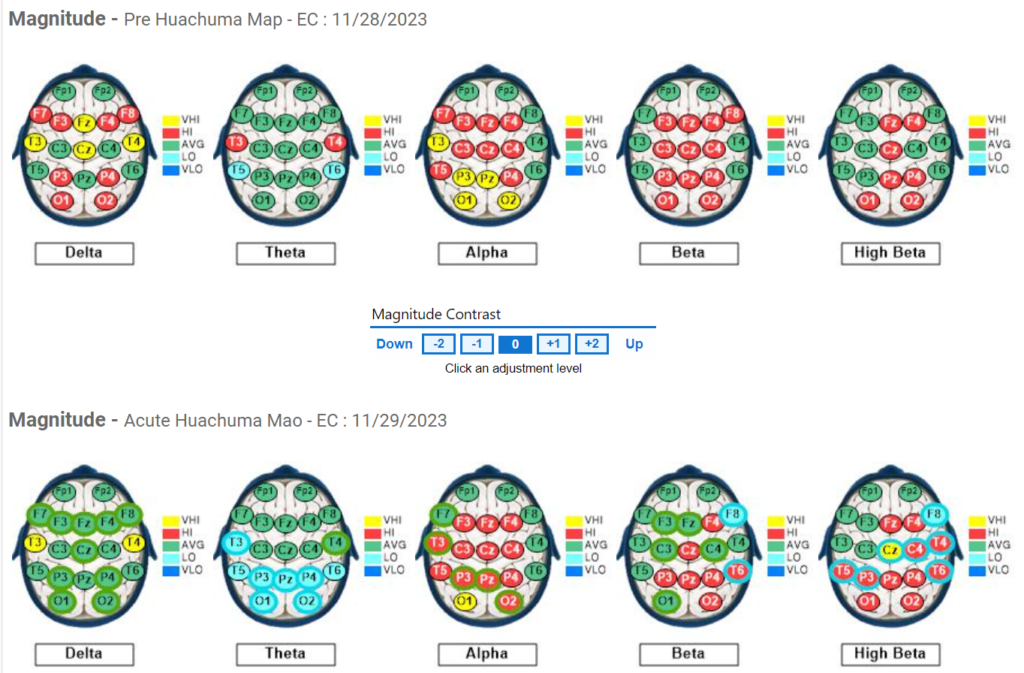
Subject #1 Pre and Post QEEG Results: We performed the post map three days after his Huachuma experience. Subject 1 experienced a 32% change and a 42% change in normalization. The high delta magnitude remained in the baseling map was greatly improved in the post map. The high alpha and high beta moved away from norm compared to the baseline map.
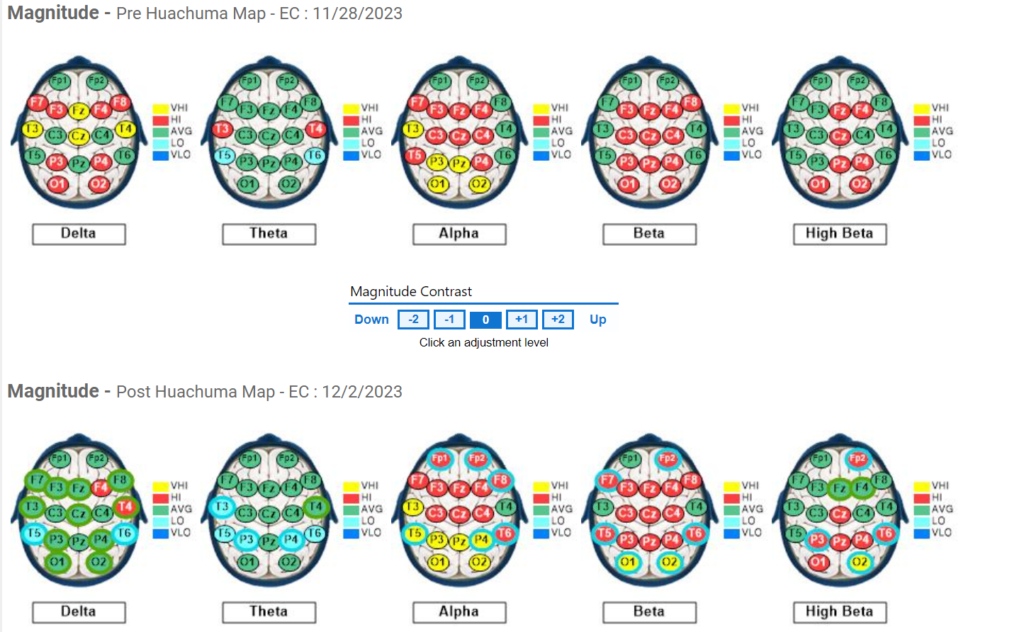
Subject #1 CEC results: Subject 1 experienced minimal change in his Cognitive Emotional Checklist and actually became slightly worse. Some confounds may be that Subject 1 has lived in the Sacred Valley of Peru for years and has done many plant medicines so one experience may not have the same subjective effect as somebody new to the medicine. In addition, we did the post brain maps in a restaurant that we thought would be slow and peaceful but turned out to be busy. Subject 1 expressed that he was stressed by this during the mapping process. This may have affected the results.
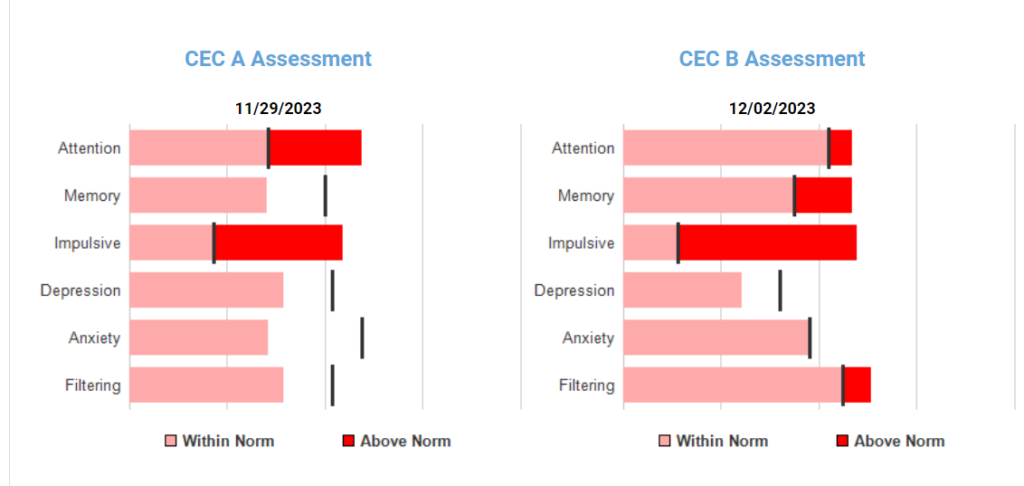
Research Subject 2 was a 37-year-old male
Subject #2 Pre and Post QEEG results: From the baseline map to the acute brain map there was a 45% change in Plasticity and a 35% change in normalization. The eyes closed map showed a significant lowering of high delta indicating a lowering of brain inflammation. Also, power levels increased in the beta and high beta.
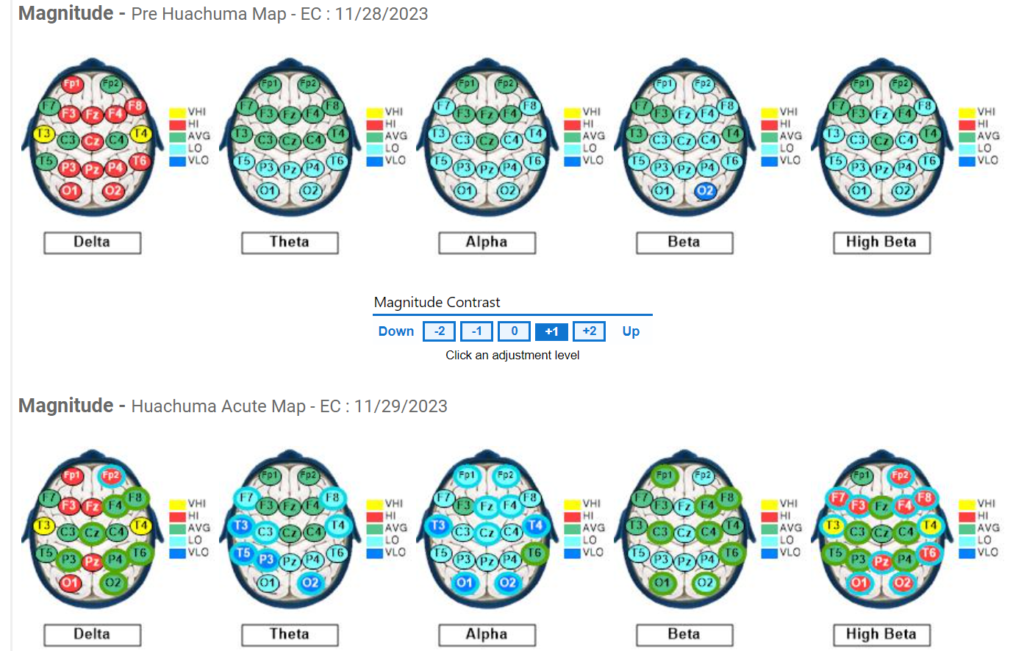
Subject #2 Pre and Post QEEG results: We performed the post map three days after his Huachuma experience. There was a 43% change in plasticity and a 39% change in normalization from the pre to the and post map. The most significant change was the high amplitude delta continued to normalize with high amplitude delta almost completely disappearing in the post map.
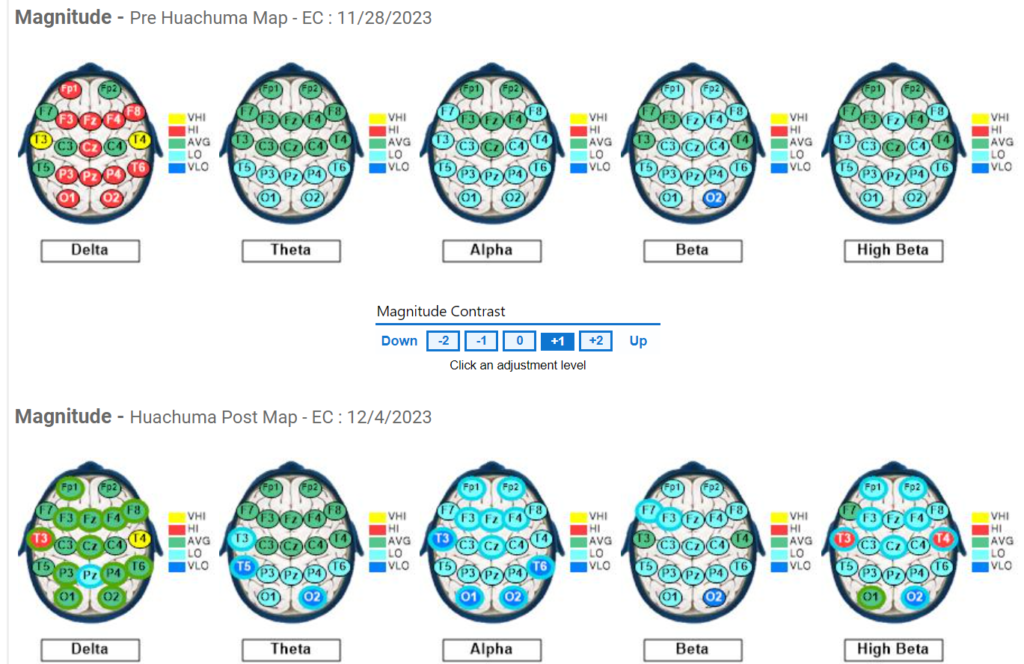
Subject #2 CEC results: Subject 2 experienced some change with all levels of measurement moving slightly in a positive direction with the Impulsive measurement moving from slightly out of norm to within norm.
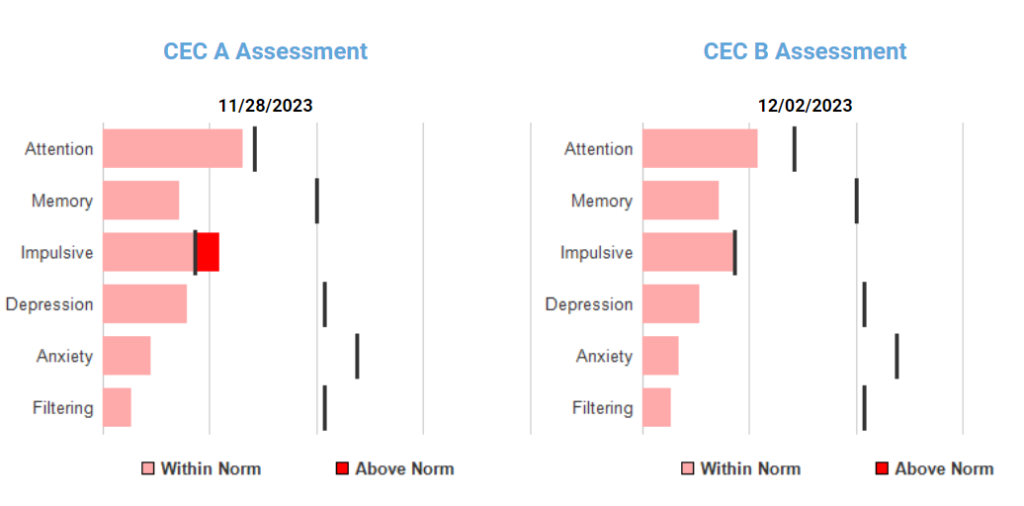
Research Subject 3 was a 54-year-old male
Subject #3 Pre and Acute QEEG results: There was a 34% change in Plasticity and a 38% change in normalization from the pre map to the acute brain map. There were two points of high alpha in the pre map and these were no longer present in the acute map. There were five points of high beta in the pre map and there was only one point in the acute map.
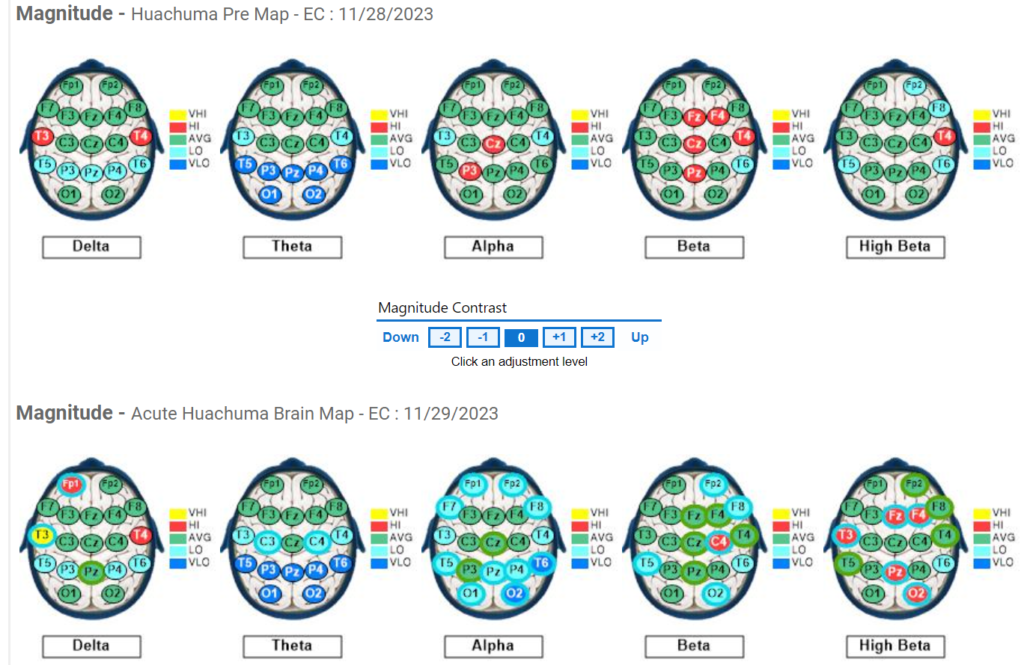
There was also a significant change in the alpha dominant frequency from an average range to fast.

Subject #3 Pre and Post QEEG Results: We performed the post map three days after his Huachuma experience. There was a 31% change in plasticity and a 41% change in normalization. In the pre map and the post map there were two points of high alpha. In the pre map there were five points of high beta and on the post map there was only one point of high beta.
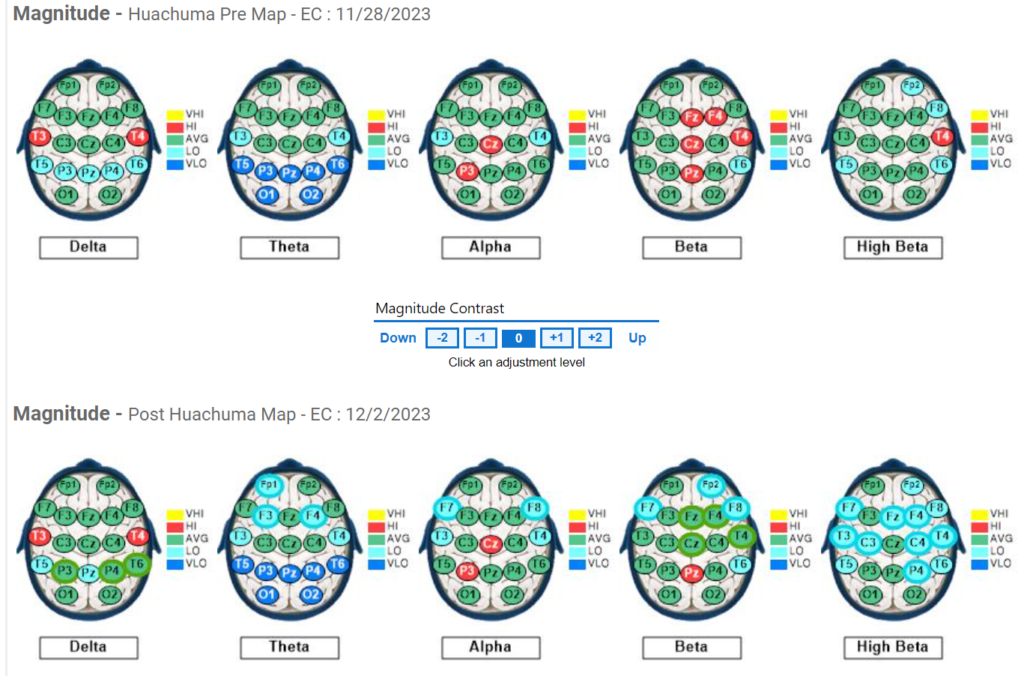
Subject #3 CEC results: Subject 3 experienced moderate change in his CEC. One measurement was out of norm in the pre assessment, Attention. In the post assessment, Attention, Impulsive, and Depression were out of norm.
Research Subject 4 was a 23-year-old female
Subject 4 Pre and Acute QEEG results: From the baseline map to the acute brain map there was a 44% change in plasticity and a 39% change in normalization. In the pre map there was high delta along the temporal lobes, high alpha towards the posterior, and one point of high beta in the posterior. All these disappeared in the acute map. Power levels did drop moderately in the beta range, and there was a lesser drop in the alpha, theta, and delta range.
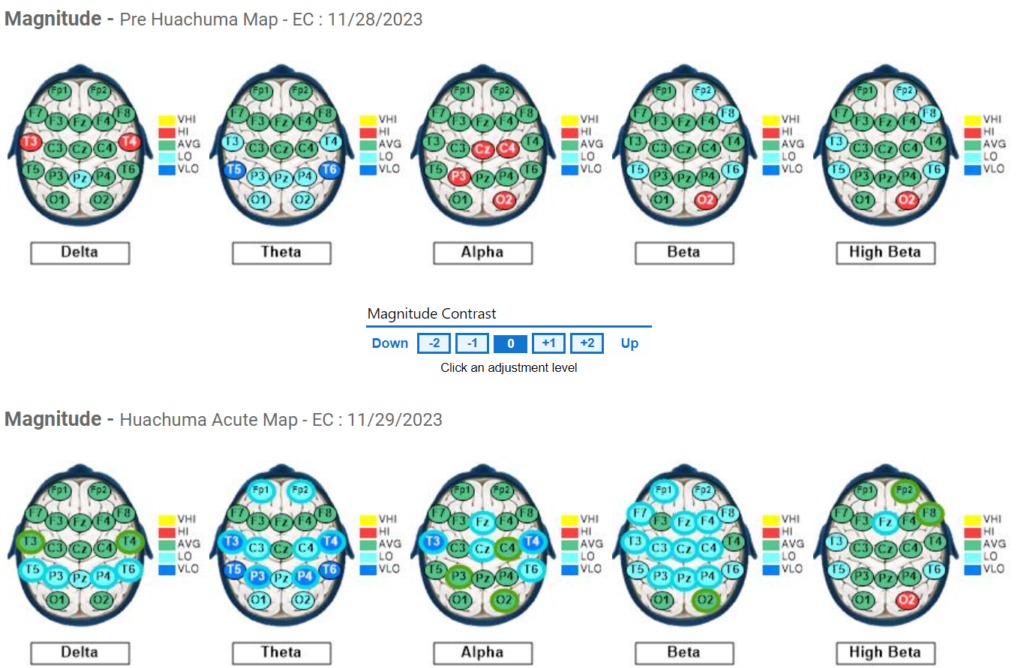
Subject #4 QEEG Pre and Post Results: We performed the post map three days after his Huachuma experience. Subject 4 experienced 32% change in plasticity and a 44% change in normalization. The topographical eyes closed map showed a return of the two points of high delta and a return of the four points of high alpha. The original point of high beta at O2 was no longer there but there was a new point at F4.
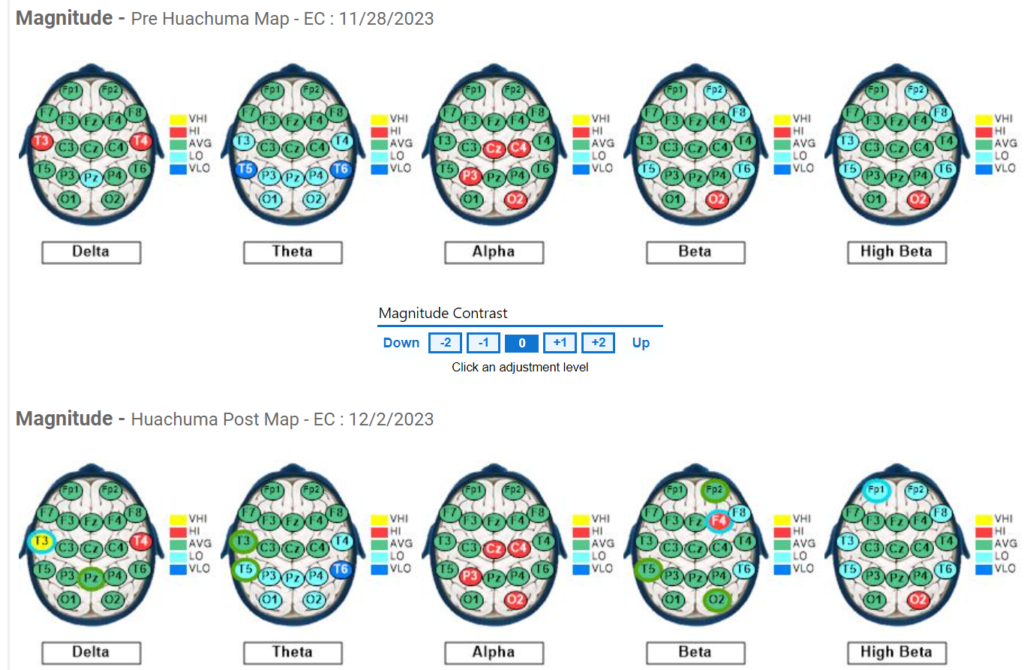
It is worth noting that in the eyes open map there was an improvement in the high amplitude alpha in the pre and post map. There was also a significant change in the beta asymmetry.

Subject 4 CEC results: Unfortunately, we were not able to get a pre CEC but the post CEC showed all measurements within norm.
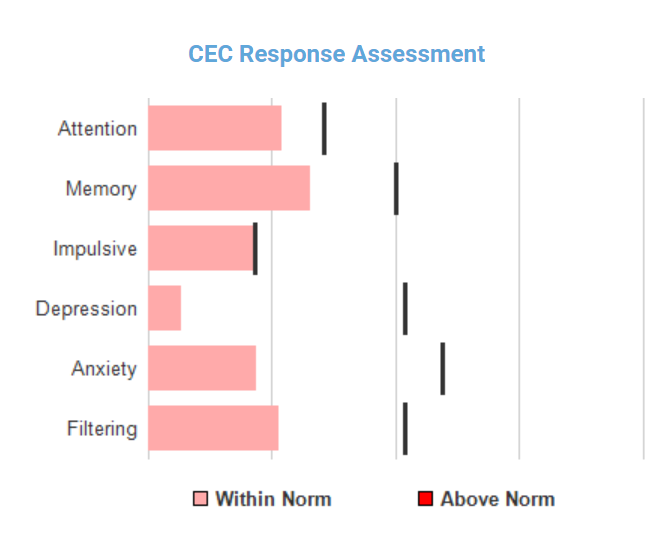
Research Subject 5 was a 41-year-old female
Subject #5 Pre and Acute QEEG results: From the baseline map to the acute brain map there was a 41% change in plasticity and a 42% change in normalization. In the pre map there was high delta globally, high theta towards the anterior, high global alpha and two points of high beta in the posterior. The high delta dropped in the acute map, the high theta in the front and along the temporal lobes dropped completely, the global alpha increased in six locations, there were two additional points of high beta that may due to muscle tension.
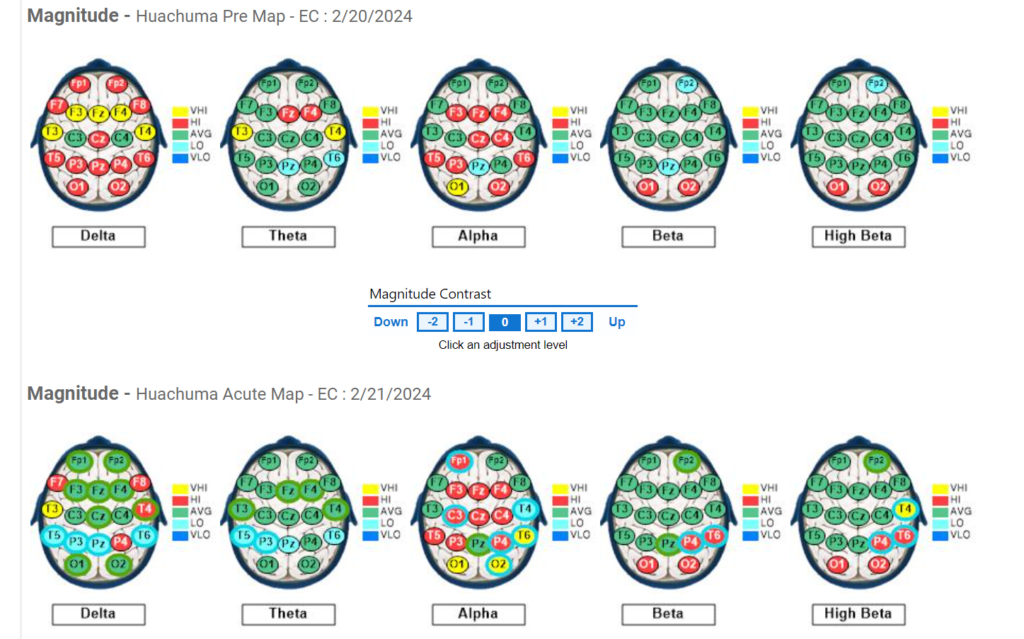
Subject #5 Network Connections: We saw a significant reduction in hyperconnectivity from the baseline map to the post map.
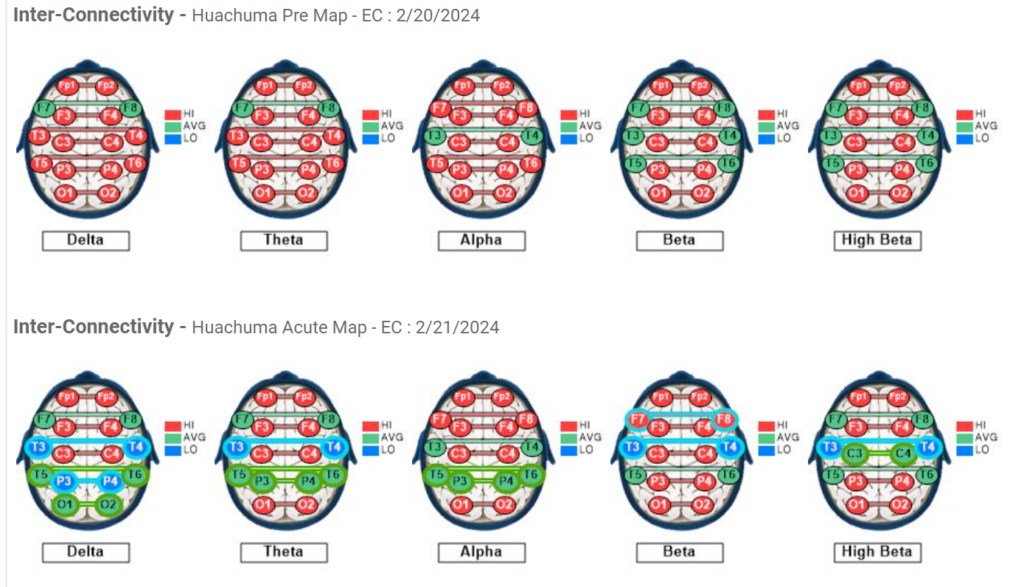
Subject #5 Pre and Post QEEG results: We performed the post map three days after his Huachuma experience. Subject 5 experienced 41% change in plasticity and a 37% change in normalization. The topographical eyes closed map continued to show low delta compared to the pre map. There were three points of high theta and global alpha was higher than the pre map. There were six points of high delta on the post compared to the two points on the pre map.
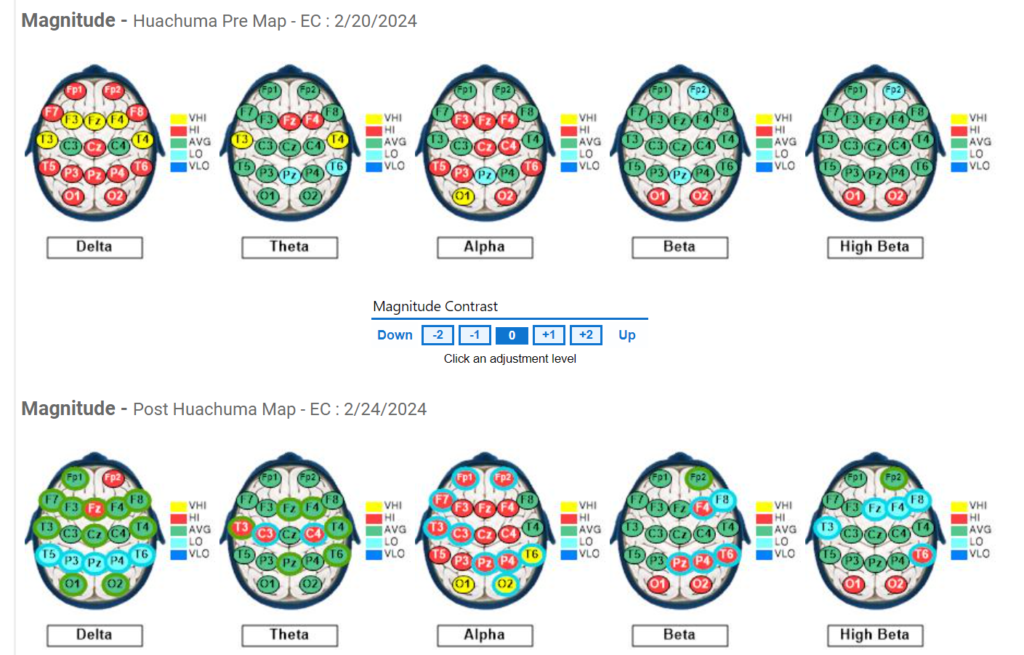
Subject #5 CEC results: There was a small amount of change in the CEC but overall, very similar. It is worth noting that subject 5 lives in the Sacred Valley and has extensive experience with plant medicines and one dose might not have the same impact as somebody trying it for the first time.
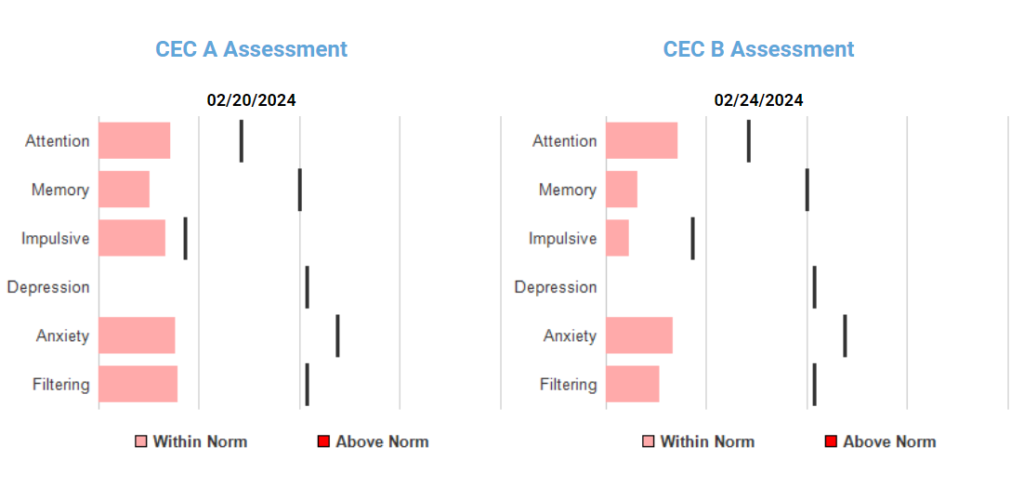
Research Subject 6 was a 32-year-old female
Subject #6 Pre and Acute QEEG results: From the baseline map to the acute brain map there was a 44% change in plasticity and a 54% change in normalization. In the pre map there was high delta in two locations and there was the same in the acute map. There was low posterior theta in the pre map and this improved in seven locations in the acute map. There were six spots of high posterior alpha in the pre map and this completely disappeared in the acute map. There was globally low beta in the pre map and four different locations move towards norm while one location moved away. Also, it is important to note that we had a bad electrode on FZ that affected all bands at the FZ location during the acute map.
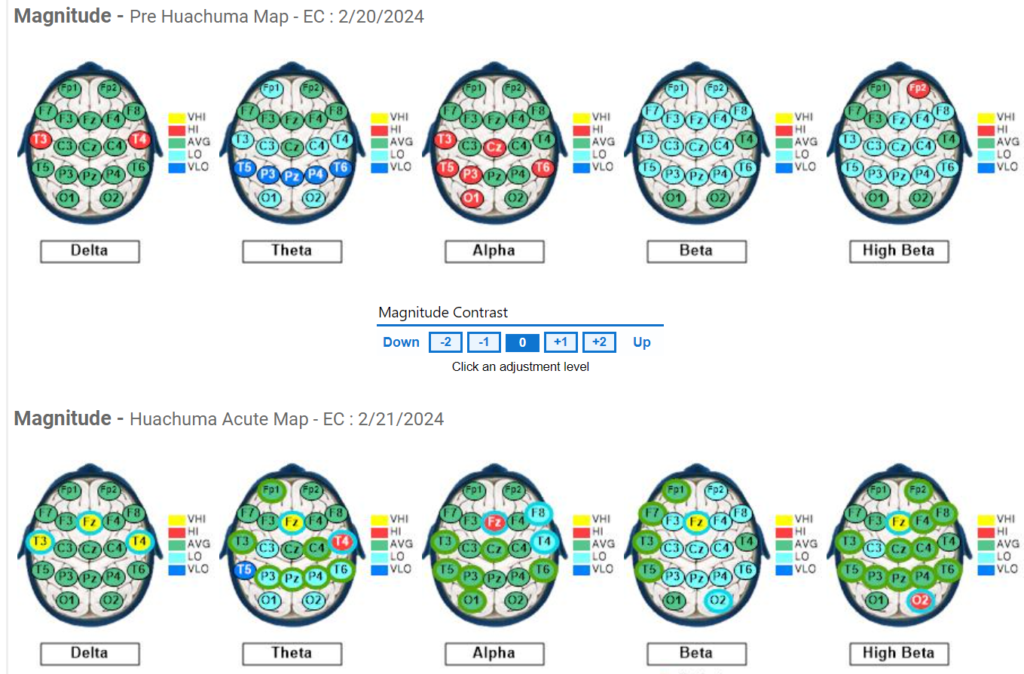
Subject #6 Pre and Post QEEG results: From the baseline brain map to the post brain map there was a 38% change in plasticity and a 39% change in normalization. The delta pattern was similar in the pre and post map and the theta pattern returned back to baseline. The alpha pattern returned to similar pattern to the baseline map with one location less of high alpha and the beta pattern was exactly the same as the baseline map.
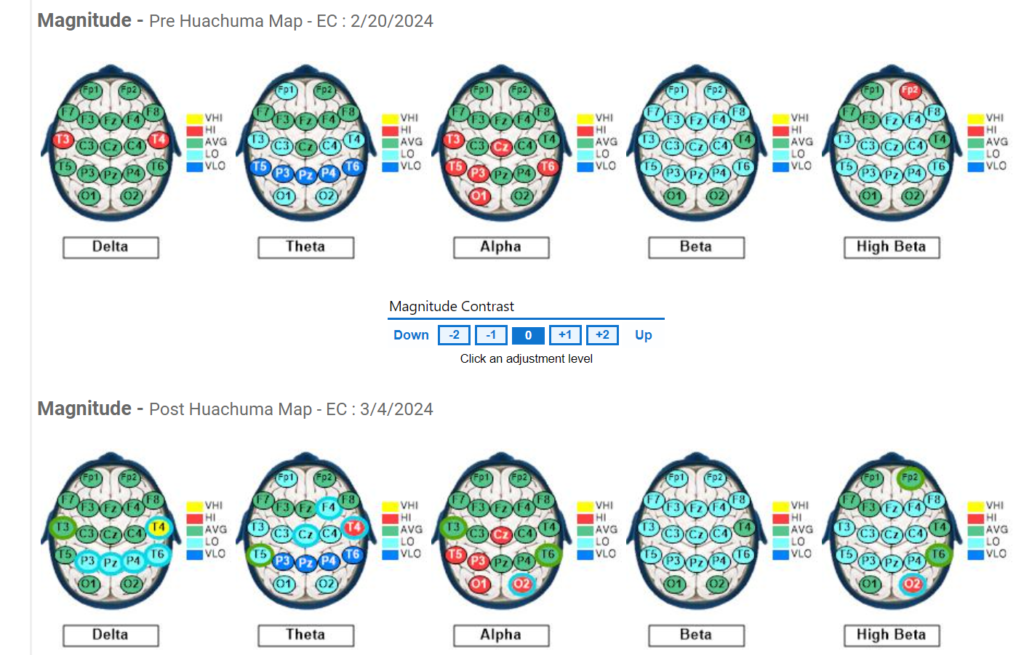
Subject #6 Asymmetry: Subject six had a dramatic improvement in alpha asymmetry from 38% to 88%, while the beta asymmetry got worse from 25% to 6%. This seems to indicate that the subject is moving out of depression, into anxiety, a natural process of healing.
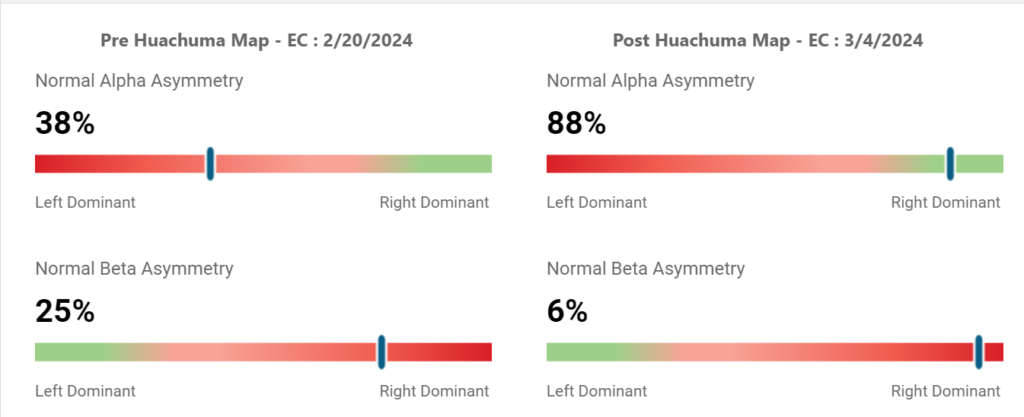
Subject #6 CEC: Subject six saw a dramatic change in the CEC, from two measurements being out of norm, impulsive and depression, to none on the post CEC. Measurements of anxiety, filtering, and attention became significantly better as well.
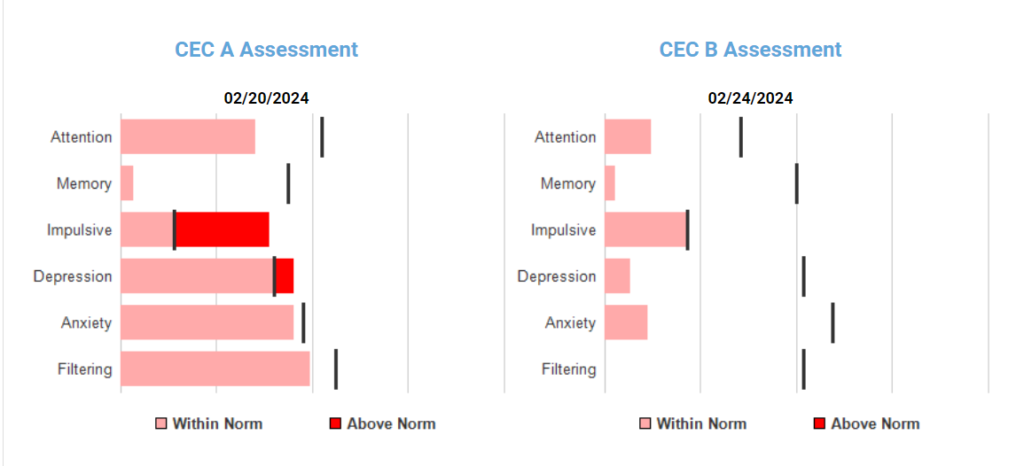
Research Subject 7 was a 24-year-old female
Subject #7 Pre and Acute QEEG results: From the baseline map to the acute brain map there was a 43% change in plasticity and a 28% change in normalization. In the baseline map there was high delta in the temporal lobes while in the acute map there was global high delta. This was likely due to body movements and shakes that can happen on Huachuma. The low posterior theta on the pre map improved in four locations on the acute map. The high posterior alpha in the baseline map completely disappeared in the acute map. There were two points of high beta in the baseline map that were gone in the acute map though power levels did drop in seven locations in beta.
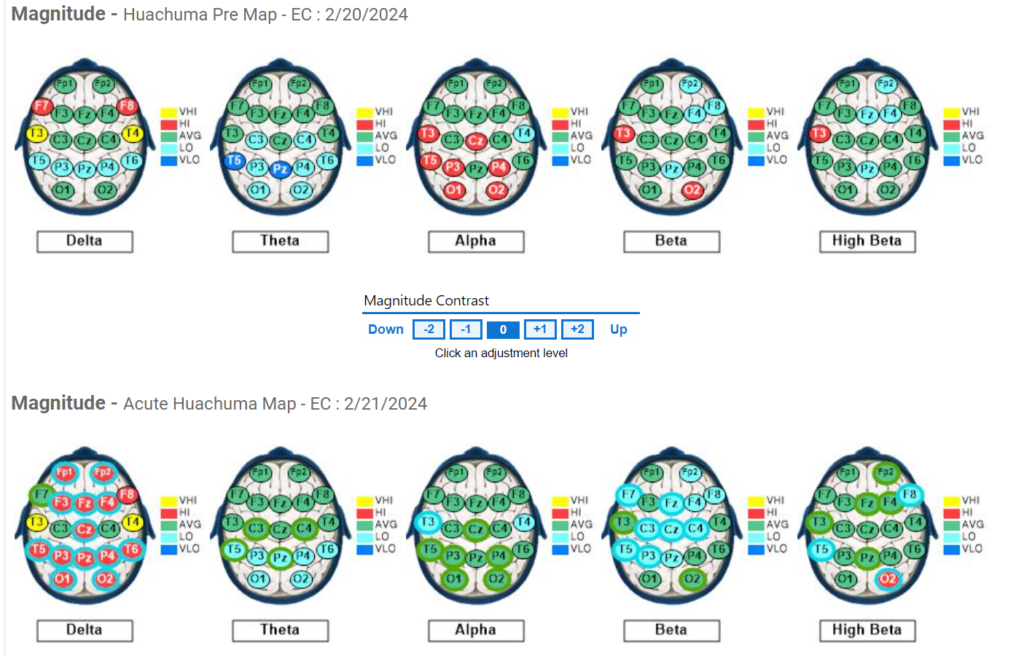
Subject #7 Pre and Post QEEG results: From the baseline map to the post map there was a 33% change in plasticity and a 40% change in normalization. From the baseline map to the post map there was an increase in delta from four locations to seven. The low theta in the posterior showed improvement in four locations. The high alpha generally came back to baseline level and posterior beta increased from baseline levels.
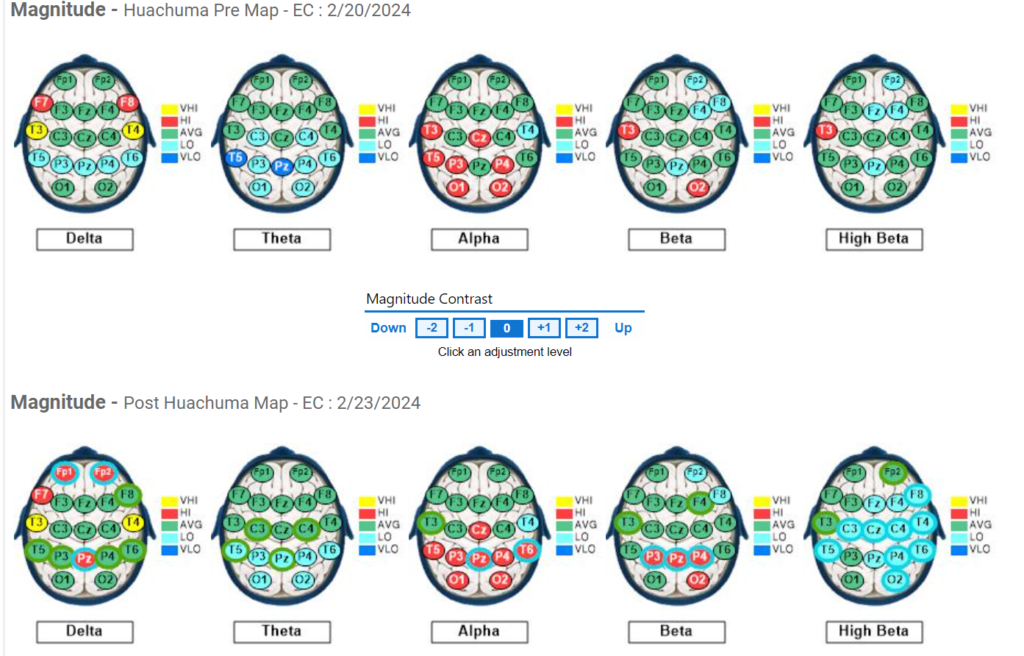
Subject #7 CEC: Subject seven’s CEC did not have the dramatic change as other participants and remained largely the same. Three measurements were out of norm in the baseline CEC and two were out of norm in the post CEC with the anxiety in measurement moving just slightly within norm.
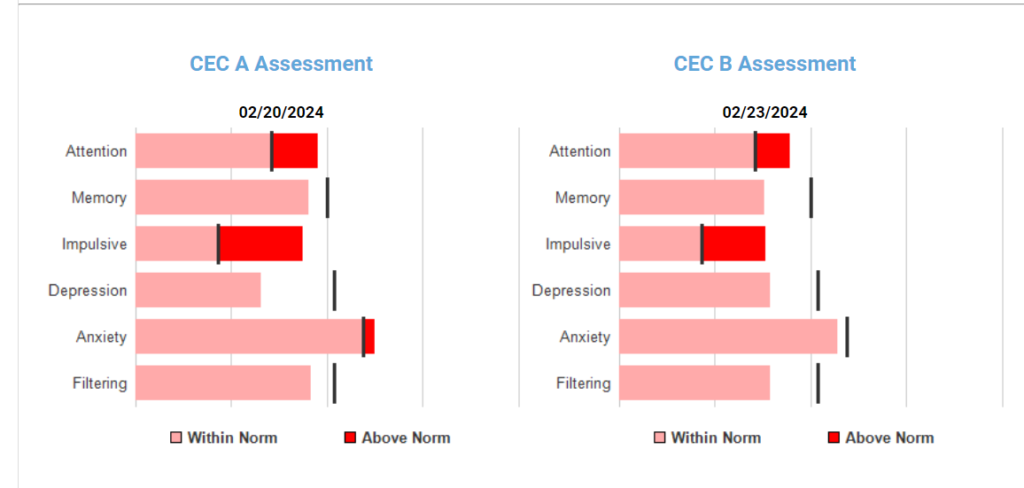
Research Subject 8 was a 30-year-old female
Subject #8 Pre and Acute QEEG results: From the baseline map to the acute brain map there was a 39% change in plasticity and a 40% change in normalization. There was a slight increase in delta in the acute map from the baseline map. This might have been due to head movement. The low posterior theta remained about the same with two sites moving towards norm and three moving away from the norm. Subject eight had significant high amplitude beta in the posterior and some in the anterior. This significantly improved in the acute map.
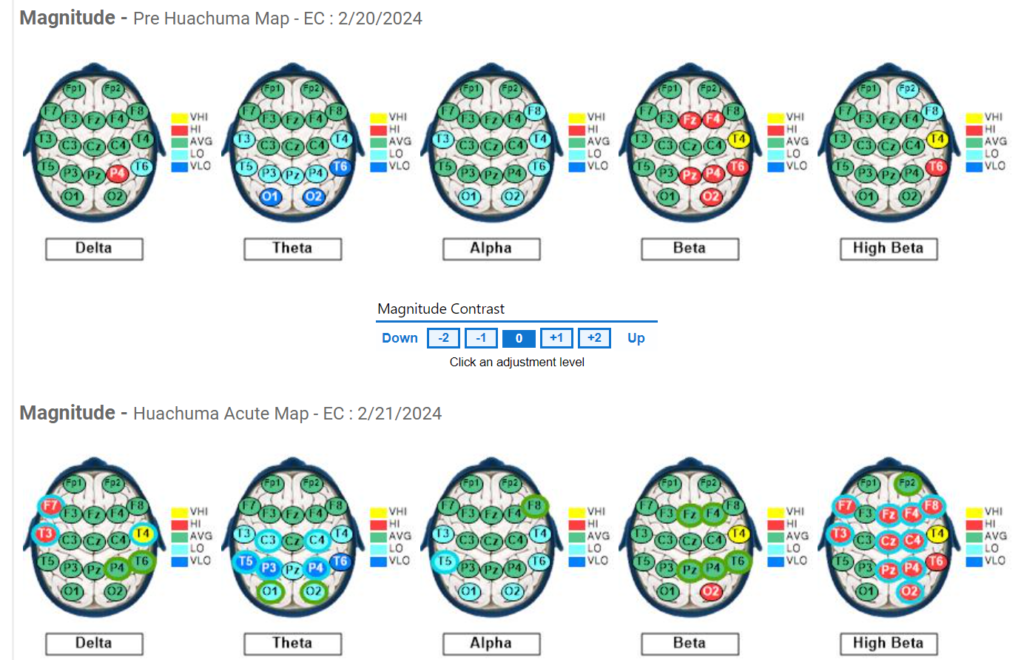
Subject #8 Alpha Dominant Frequency: Alpha dominant frequency normalized the baseline map to the acute map.

Subject #8 Inter-Connectivity: There was significant hypo connection in delta in the baseline map that went away in the acute map.
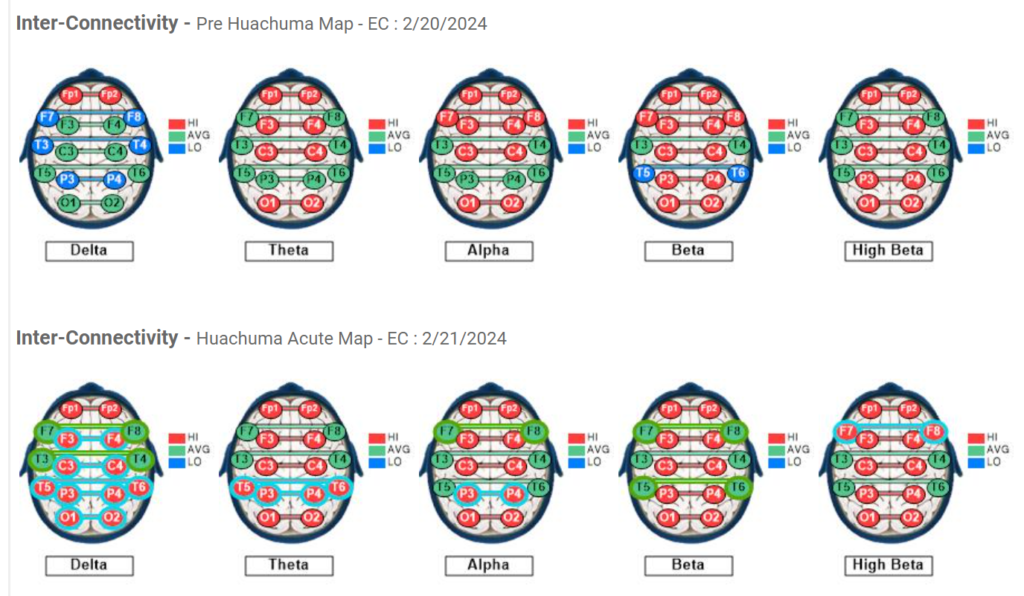
Subject #8 Pre and Post QEEG results: From the baseline map to the post brain map there was a 38% change in plasticity and a 42% change in normalization. The one point of high delta in the posterior in the baseline map disappeared in the post map. In the baseline map there was no high alpha and in the post map there was significant high alpha. In the post map the posterior high amplitude beta became worse with three additional points out of norm.
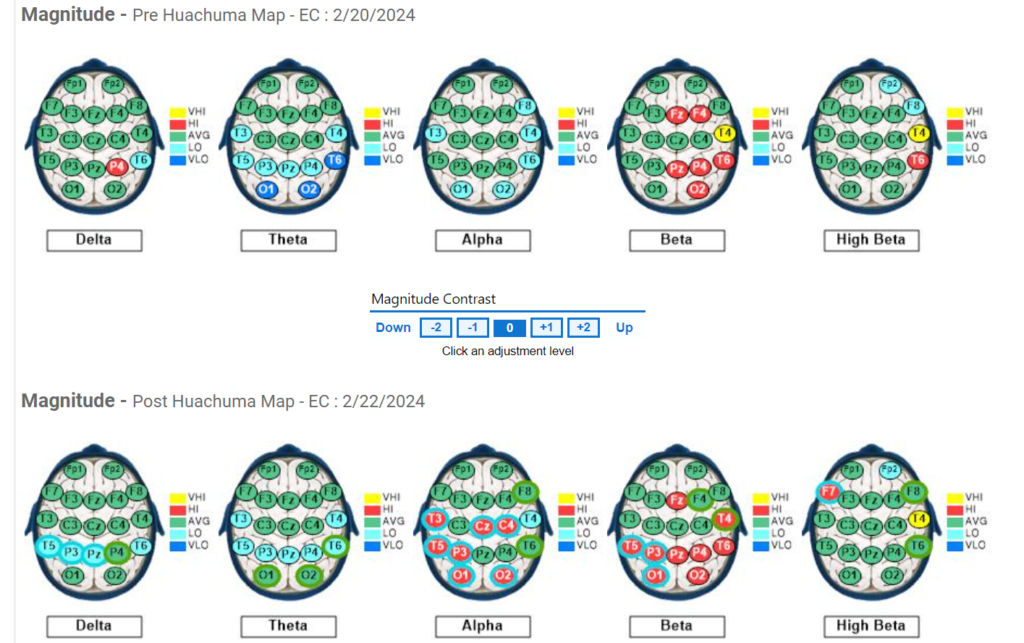
Subject #8 CEC: There was a moderate improvement on the subject eight’s CEC. There was one measurement out of norm on the baseline CEC and all were within norm on the post CEC. Even though anxiety was within norm on the baseline, it did improve on the post CEC.
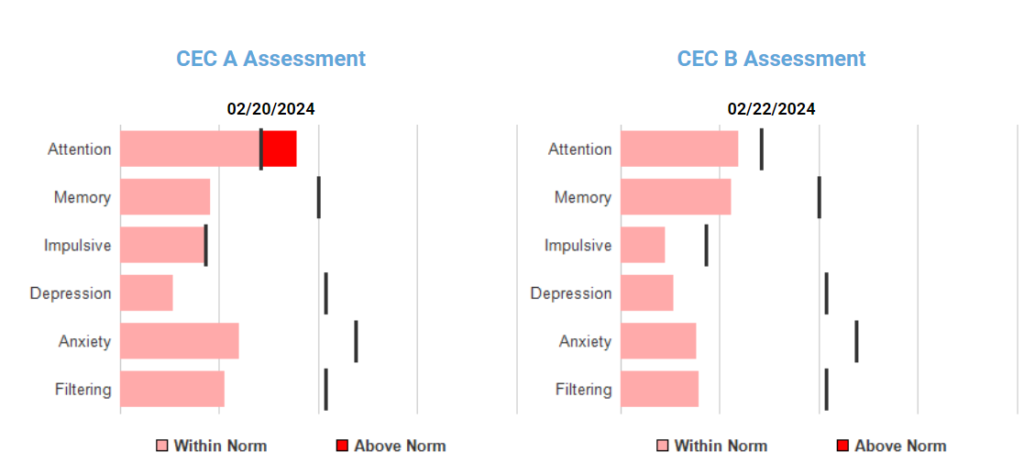
Research Subject 9 was a 31-year-old female
Subject #9 Pre and Acute QEEG results: From the baseline map to the acute brain map there was a 42% change in plasticity and a 41% change in normalization. The baseline map had no high delta while the acute map did, this is likely during movement during Huachuma. The low posterior theta on the baseline became slightly worse in the acute map. The high posterior alpha in the baseline map remained about the same in the acute map. The low global beta in the baseline map remained in the acute map. Also, the FZ electrode in the acute map was faulty and all data from this location in the acute map must be disregarded.
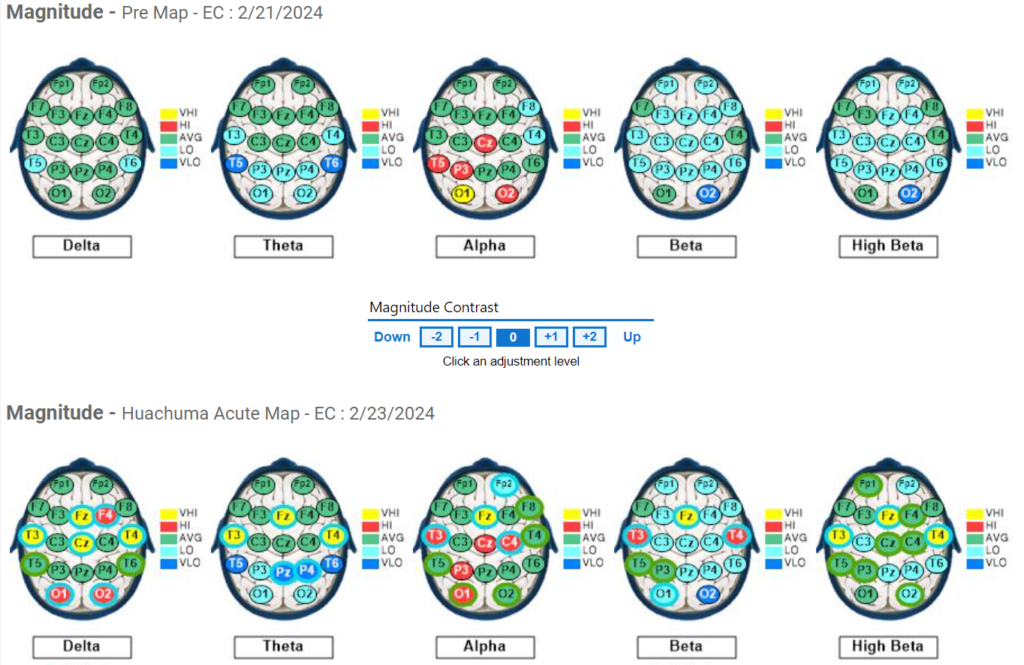
Subject #9 Pre and Post QEEG results: From the baseline map to the post brain map there was a 42% change in plasticity and a 47% change in normalization. There was no high delta in the baseline map and there were four locations in the post map. The low posterior theta in the baseline map improved in the post map. The high posterior alpha in the baseline map improved in the post map with the addition of some drop in alpha power. The low global beta in the baseline map remained in the post map.
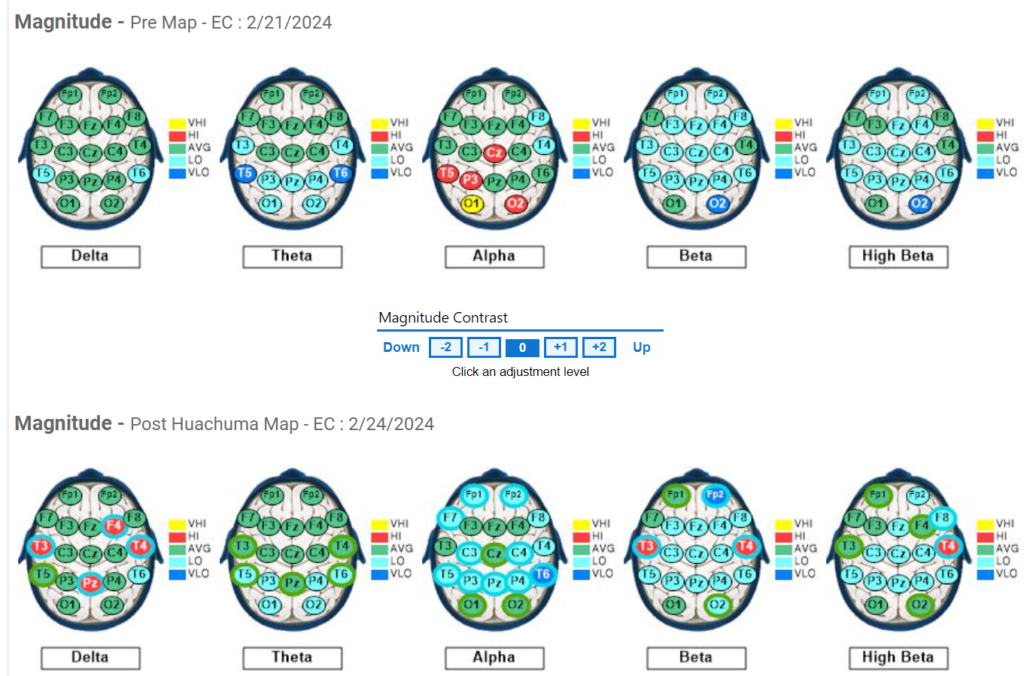
Subject #9 Alpha Dominant Frequency: In addition, subject eight experienced a significant change in alpha dominant frequency, from being on the fast side in the baseline map to moving in a normalized direction in the post map.

Subject #9 CEC: Subject nine experienced minimal change in the CEC.
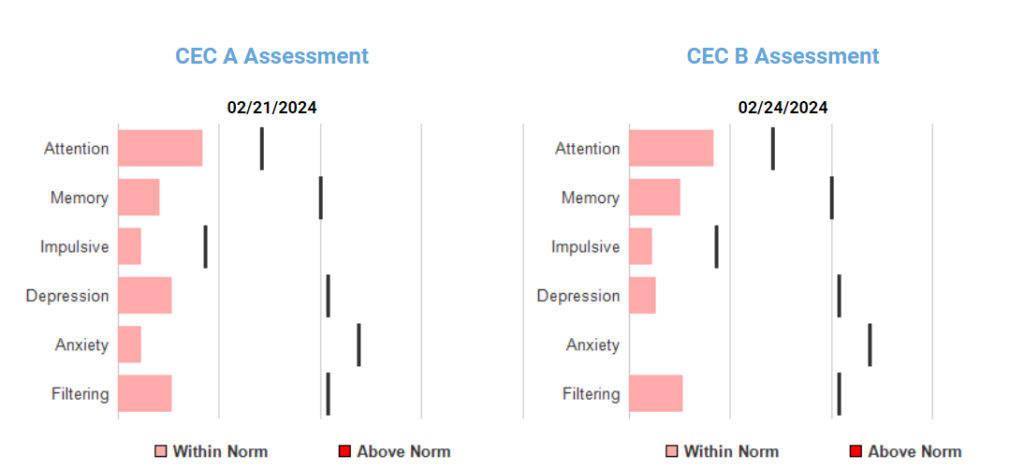
Research Subject 10 was a 44-year-old male
Subject #10 Pre and Acute QEEG results: From the baseline map to the acute brain map there was a 51% change in plasticity and a 44% change in normalization. On the baseline map there some high temporal delta which may have worsened in the acute map or it may have been due to movement. The low posterior theta in the baseline map remained in the acute map. The low global alpha in the baseline map became worse in the acute map. The low global beta in the baseline map improved in the acute map. There may be a draining of the power levels due to the plant medicine that was affecting the alpha and beta.
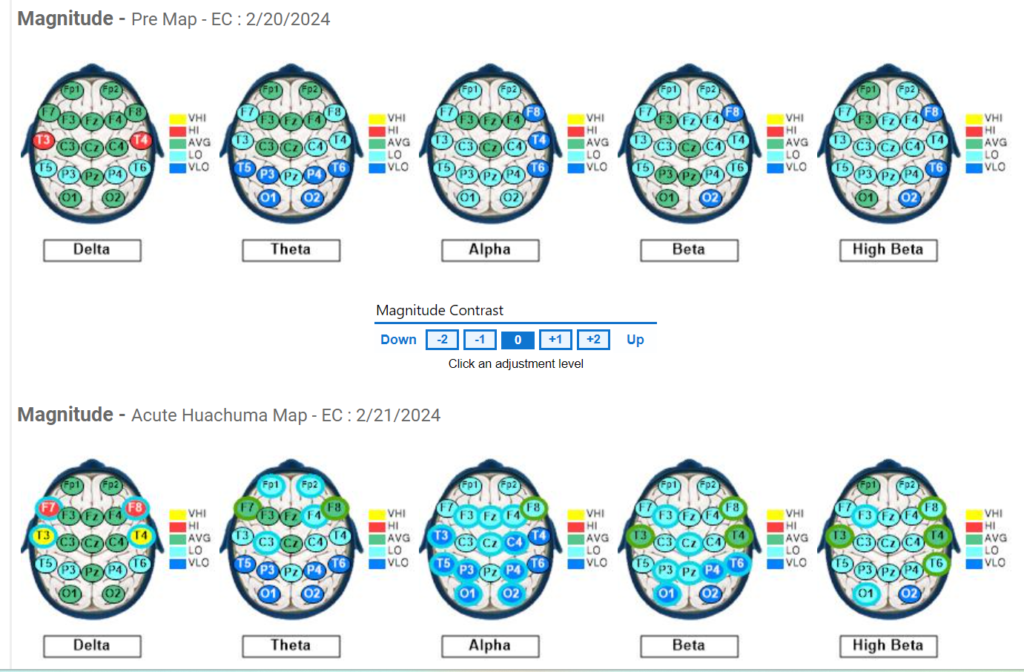
Subject #10 Inter-Connectivity: From the baseline map to the acute map there was a dramatic reduction in hyperconnectivity and some normalizing of hypoconnectivity.
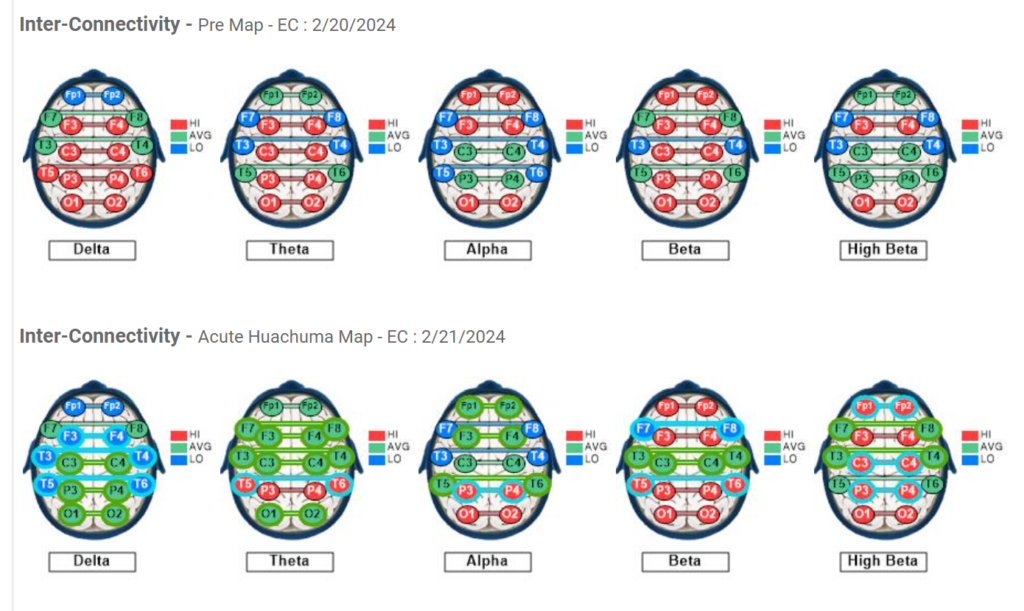
Subject #10 Pre and Post QEEG results: From the baseline map to the post brain map there was a 32% change in plasticity and a 46% change in normalization. Most of the patterns of magnitude from the baseline map returned in the post map.
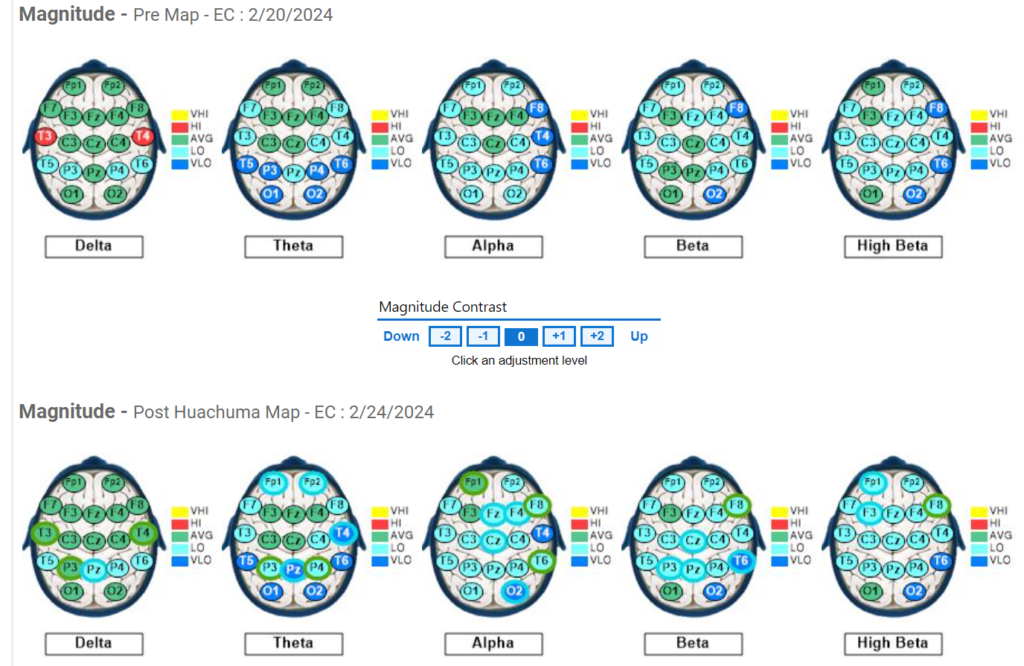
Subject #10 Inter-Connectivity: Subject ten experienced a significant amount of change in connectivity between networks from the baseline map to the post map.
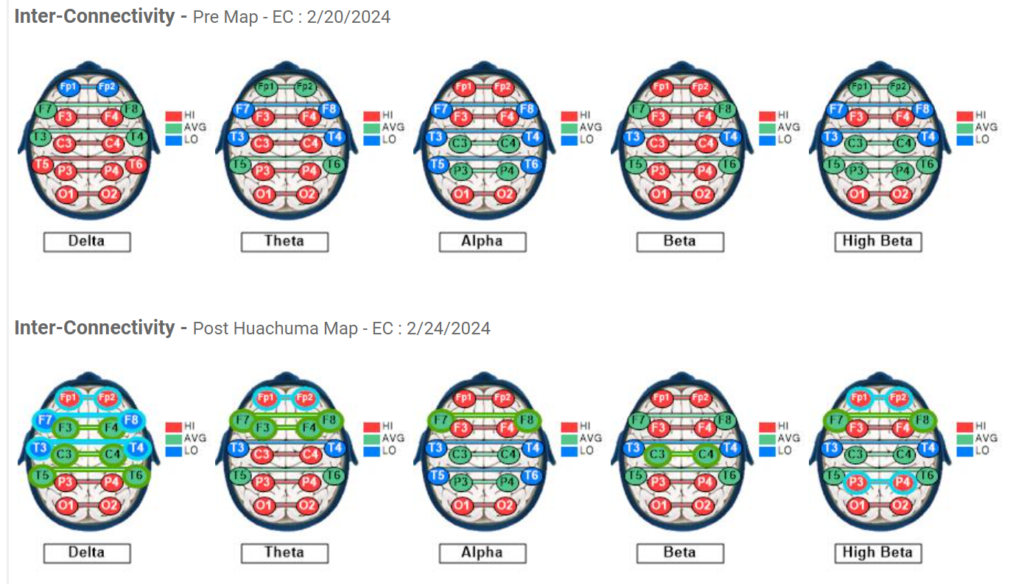
Subject #10 CEC: Subject nine experienced small change in the CEC. Subject ten had two measurements out of norm in the baseline CEC and these measurements continued to be out of norm in the post CEC but with some improvement. Other measures improved as well.
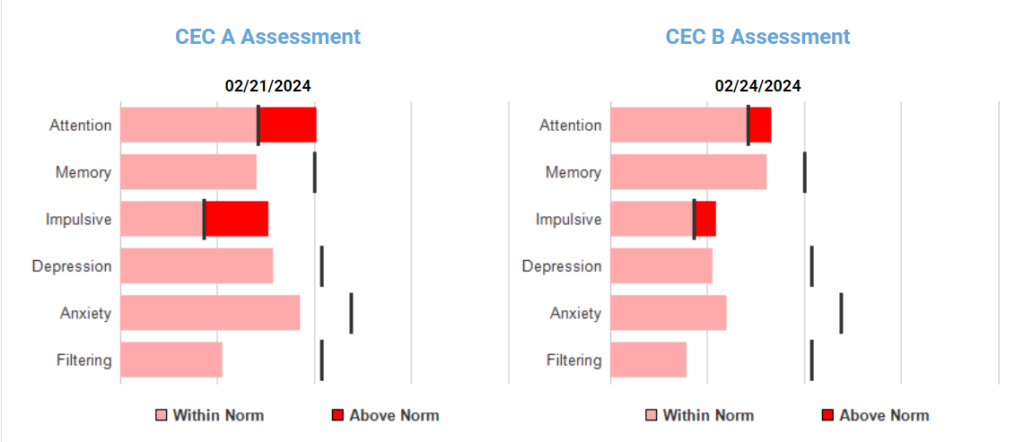
Discussion and Conclusion
One of the most important takeaways from this study was the large percentage of change in the measures of plasticity and normalization. As stated previously, according to the New Mind Technologies system, a 28-38% change is the norm after a complete neurofeedback treatment. An average change day to day can vary between 15% to 20%. The average change from pre to post map as measured by the New Mind Technologies mapping system was 39%. The average change in normalization was 41% as measured by the New Mind Technologies mapping system. Thus we are seeing a very significant change over a short period of time.
| Overall Change | Change in Normalization | ||
| Subject 1 | Pre and Acute | 40% | 41% |
| Pre and Post | 32% | 42% | |
| Subject 2 | Pre and Acute | 45% | 35% |
| Pre and Post | 43% | 39% | |
| Subject 3 | Pre and Acute | 34% | 38% |
| Pre and Post | 31% | 41% | |
| Subject 4 | Pre and Acute | 44% | 39% |
| Pre and Post | 32% | 44% | |
| Subject 5 | Pre and Acute | 41% | 42% |
| Pre and Post | 41% | 37% | |
| Subject 6 | Pre and Acute | 44% | 54% |
| Pre and Post | 38% | 39% | |
| Subject 7 | Pre and Acute | 43% | 28% |
| Pre and Post | 33% | 40% | |
| Subject 8 | Pre and Acute | 39% | 40% |
| Pre and Post | 38% | 42% | |
| Subject 9 | Pre and Acute | 42% | 41% |
| Pre and Post | 42% | 47% | |
| Subject 10 | Pre and Acute | 51% | 44% |
| Pre and Post | 32% | 46% |
Though there has been a significant increase in psychedelic research in the last ten years there remain many gaps needing further investigation. Mescaline in general and Huachuma in particular are areas that would benefit from more analysis. This initial brain mapping study is a step in that direction.
From our brain mapping it seems that Huahcuma moves each person’s brain in a unique direction that is “needed” for them. It does not move everybody’s brain in the same direction as might be expected. It heals each person in an individual way. For some, this was a decreasing in markers of inflammation in the delta range. For others, it may be increase in power levels. For others, it may be a decreasing in alpha magnitude, indicating a relaxing mind. We have also seen both an increase in hyper connection in some people or an increase in hypo connection in other people or just general change in network connections. Some people’s alpha and beta asymmetry changed, sometimes in a healthy direction and sometimes in a way that indicates a possible processing of emotional stress.
What is most intriguing is why each individual’s brain function seemed to normalize and move into a healthy direction that was unique to them. Early in the studies of psychedelics people believed that they induced psychosis or states similar to schizophrenia. We have found the exact opposite; from preliminary research the majority of people’s brain function seems to move in a healthy direction. It would seem that the theory put forth by Soutar (2024) that each brain and nervous system stores trauma in a unique way is being validated by this initial plant medicine research. What appears to be happening is that as trauma is processed the brain becomes more regulated. To state this idea in another way, trauma itself is held in the brain through a few major mechanisms that are reflected in brain function. As the trauma is released the brain normalizes. We believe that this brain trauma model is critical to future research both in the realm of plant medicines and beyond. A better understanding of this model can lead to more efficient methods of healing.
This was our first study we conducted where there was a baseline map, an acute map, and a post map. This is, as far as we know, the only study of this type ever conducted on any psychedelic, with all other studies that we know of only mapping during the acute experience. This has given us unique insight into how the brain changes over time. Most of the maps saw a move to a healthier state from the baseline map to the acute map. From the baseline map to the post map it seemed that some brains returned to something similar to their baseline level while others continued to improve. Another interesting avenue of further research would be to take additional QEEG maps a few weeks or a few months later to learn how long the effects last.
Possible confounds of this study would be the unique population that we brain mapped. We brain mapped people mostly living in the Sacred Valley Peru, with two participants that were working temporarily on an organic farm. This population was originally born in different countries. This population is also more experienced in plant medicines and often takes them on a regular basis in either personal or shamanic use. One ceremony for this population might not have the same effect as somebody traveling through and trying it for the first time. Another possible confound is that this population might have a different psychological type than the average person living in North America. The population of expatriates living in the Sacred Valley have all chosen to leave their home country for certain reasons. They might have more psychological issues than the average person, they may simply want a less stressful life, or it could be many other variables. If they moved to Peru for deep healing it is possible that one ceremony might not have the same impact, and they might need longer treatment time. In Peru, these longer shamanic healings are called dieatas are often used where people go into isolation and work with plants for weeks, months, or for some even years.
We are in a critical time and much research needs be done with plant medicines. As we gain ground in research, we will find new ways to heal. In this study we have seen that plant medicines can have an impact on brain inflammation along with many other markers. It seems that as psychological stress is removed, the brain moves in a healthy direction.
The promise of healing through plant medicines is both a new paradigm and an old one. It is the modern world looking towards our ancient past and other traditional societies for other methods of healing outside the conventional view. This path of exploration is both humbling and liberating. Humbling because it will make us rethink many paradigms that we have held true for so long. Liberating in that it will free us from conventional rigid models like the prescription drug model and the often-atomizing psychological model and show the wholeness of the spiritual experience and all the doorways that it may open.
Arne Bohn, Michiel H. H. Kiggen, Malin V. Uthaug, Kim I. M. van Oorsouw, Johannes G. Ramaekers & Hein T. van Schie (2022) Altered States of Consciousness During Ceremonial San Pedro Use, The International Journal for the Psychology of Religion, Advance online publication. https://doi.org/10.1080/10508619.2022.2139502
Agin-Liebes, G., Haas, T. F., Lancelotta, R., Uthaug, M. V., Ramaekers, J. G., & Davis, A. K. (2021). Naturalistic Use of Mescaline Is Associated with Self-Reported PsychiatricImprovements and Enduring Positive Life Changes. ACS pharmacology & translationalscience, 4(2), 543–552. https://doi.org/10.1021/acsptsci.1c00018
Armour, M., Smith, C. A., Wang, L. Q., Naidoo, D., Yang, G. Y., MacPherson, H., Lee, M. S., &Hay, P. (2019). Acupuncture for Depression: A Systematic Review and Meta-Analysis. Journal of clinical medicine, 8(8), 1140. https://doi.org/10.3390/jcm8081140
Arne Bohn, Michiel H. H. Kiggen, Malin V. Uthaug, Kim I. M. van Oorsouw, Johannes G. Ramaekers & Hein T. van Schie (2022) Altered States of Consciousness During Ceremonial San Pedro Use, The International Journal for the Psychology of Religion, Advance online publication. https://doi.org/10.1080/10508619.2022.2139502
Barrett, F. S., & Griffiths, R. R. (2018). Classic Hallucinogens and Mystical Experiences: Phenomenology and Neural Correlates. Current topics in behavioral neurosciences, 36, 393–430. https://doi.org/10.1007/7854_2017_474
Bonson K. R. (2018). Regulation of human research with LSD in the United States (1949-1987). Psychopharmacology, 235(2), 591–604. https://doi.org/10.1007/s00213-017-4777-4
Denber, H. C., & Merlis, S. (1955). Studies on mescaline. I. Action in schizophrenic patients; clinical observations and brain wave patterns, showing effects before and after electric convulsive treatments. The Psychiatric quarterly, 29(3), 421–429.
Dos Santos, R. G., Bouso, J. C., & Hallak, J. E. C. (2019). Serotonergic hallucinogens/psychedelics could be promising treatments for depressive and anxiety disorders in end-stage cancer. BMC psychiatry, 19(1), 321. https://doi.org/10.1186/s12888-019-2288-z
Friesen P. (2022). Psychosis and psychedelics: Historical entanglements and contemporary contrasts. Transcultural psychiatry, 59(5), 592–609. https://doi.org/10.1177/13634615221129116
Gukasyan, N., Mathur, B. N., & Barrett, F. S. (2021). Psychedelics and Consciousness: Distinctions, Demarcations, and Opportunities. The international journal of neuropsychopharmacology, 24(8), 615–623. https://doi.org/10.1093/ijnp/pyab026
Jay, M. (2019). Mescaline: A global history of the first psychedelic. Yale University Press Cassels, B. K., & Sáez-Briones, P. (2018). Dark Classics in Chemical Neuroscience: Mescaline. ACS chemical neuroscience, 9(10), 2448–2458. https://doi.org/10.1021/acschemneuro.8b00215
Kangaslampi, S. (2023). Association between mystical-type experiences under psychedelics and improvements in well-being or mental health – A comprehensive review of the evidence. Journal of Psychedelic Studies, 7(1), 18-28. https://doi.org/10.1556/2054.2023.00243
Liechti, M. E., Dolder, P. C., & Schmid, Y. (2017). Alterations of consciousness and mystical-type experiences after acute LSD in humans. Psychopharmacology, 234(9-10), 1499–1510. https://doi.org/10.1007/s00213-016-4453-0
Tafur, J. (2017). Fellowship of the River. Espirito Books.
Lu, Donna (2021, September, 26). Psychedelics renaissance’: new wave of research puts hallucinogenics forward to treat mental health. The Guardian. https://www.theguardian.com/society/2021/sep/26/psychedelics-renaissance-new-wave-of-research-puts-hallucinogenics-forward-to-treat-mental-health
McCulloch, D. E., Knudsen, G. M., Barrett, F. S., Doss, M. K., Carhart-Harris, R. L., Rosas, F. E., Deco, G., Kringelbach, M. L., Preller, K. H., Ramaekers, J. G., Mason, N. L., Müller, F., & Fisher, P. M. (2022). Psychedelic resting-state neuroimaging: A review and perspective on balancing replication and novel analyses. Neuroscience and biobehavioral reviews, 138, 104689. https://doi.org/10.1016/j.neubiorev.2022.104689
Merlis, S. (1957). The effects of mescaline sulfate in chronic schizophrenia. The Journal of nervous and mental disease, 125(3), 432–434. https://doi.org/10.1097/00005053-195707000-00014
Nutt, D. J., King, L. A., & Nichols, D. E. (2013). Effects of Schedule I drug laws on neuroscience research and treatment innovation. Nature reviews. Neuroscience, 14(8), 577–585. https://doi.org/10.1038/nrn3530
Oepen, G., Fuenfgeld, M., Harrington, A., Hermle, L., & Botsch, H. (1989). Right hemisphere involvement in mescaline-induced psychosis. Psychiatry research, 29(3), 335–336. https://doi.org/10.1016/0165-1781(89)90081-4
Prentiss, D.W. & Morgan, F.P. (1895). Anhalonium lewinii (mescal buttons). George S. Davis, pp. 577-585.
Rush, Brian & Marcus, Olivia & Shore, Ron & Cunningham, Leann & Thomson, Nina &Rideout, Kaitlyn. (2022). Psychedelic Medicine: A Rapid Review of Therapeutic Applications and Implications for Future Research. Homewood Research Institute. https://hriresearch.com/research/exploratory-research/research-reports
Schultes RE, Hofmann A, & Rätsch C (2001). Plants of the Gods: Their Sacred, Healing, and Hallucinogenic Powers. Healing Arts Press.
Soutar, R (2024). Integrating Trauma With Alpha Theta Neurofeedback. Murfreesboro, TN. Foundation for Neurofeedback and Neuromodulation Research.
Vamvakopoulou, I. A., Narine, K. A. D., Campbell, I., Dyck, J. R. B., & Nutt, D. J. (2023). Mescaline: The forgotten psychedelic. Neuropharmacology, 222, 109294. https://doi.org/10.1016/j.neuropharm.2022.109294
Uthaug, M. V., Davis, A. K., Haas, T. F., Davis, D., Dolan, S. B., Lancelotta, R., Timmermann, C., & Ramaekers, J. G. (2022). The epidemiology of mescaline use: Pattern of use, motivations for consumption, and perceived consequences, benefits, and acute and enduring subjective effects. Journal of psychopharmacology (Oxford, England), 36(3), 309–320. https://doi.org/10.1177/02698811211013583
Yaden, D. B., Johnson, M. W., Griffiths, R. R., Doss, M. K., Garcia-Romeu, A., Nayak, S., Gukasyan, N., Mathur, B. N., & Barrett, F. S. (2021). Psychedelics and Consciousness: Distinctions, Demarcations, and Opportunities. The international journal of neuropsychopharmacology, 24(8), 615–623. https://doi.org/10.1093/ijnp/pyab026